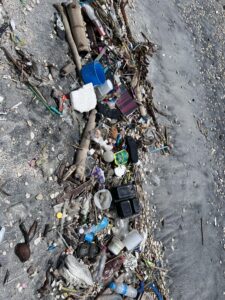
photo taken before the September21 2024 clean up
Every year, the Philippines generates 2.7 trillion plastic items. While some are recycled or properly disposed of, a significant portion finds its way into rivers, estuaries, and ultimately, the ocean. A single discarded plastic bottle can travel miles, harming marine life, polluting ecosystems, and contributing to the global climate crisis.
At Earthshore, we are committed to cleaning coastal communities, including those in the Philippines. In September, we removed 65 kg of plastic waste from Manila Bay, but the fight against plastic pollution is far from over.
How a Plastic Bottle Ends Up in the Ocean
The life cycle of a plastic bottle doesn’t end after it’s thrown away. Many assume that plastics go directly to landfills, but in reality, they often take a much more harmful path:
-
- Discarded Plastic – Whether tossed on the street, left on the beach, or improperly disposed of, plastic bottles can quickly enter the environment.
-
- Transport via Waterways – Rain and wind carry plastic waste into storm drains, rivers, and streams, moving it toward larger bodies of water.
-
- Accumulation in the Ocean – Once plastic enters the ocean, it doesn’t just disappear. Instead, it breaks down into microplastics, which are consumed by fish and marine animals—eventually entering our food chain.
-
- Impact on Marine Life – Sea turtles mistake plastic for jellyfish, seabirds feed it to their chicks, and fish ingest toxic microplastics, leading to health issues and ecosystem disruption.
The Reality of Plastic Pollution in the Philippines
The Philippines is one of the world’s largest contributors to plastic waste in the ocean, largely due to its archipelagic nature and inefficient waste management systems. Coastal cities, informal settlements near waterways, and a high dependence on single-use plastics all contribute to the overwhelming volume of waste entering the sea.
Plastic pollution isn’t just an environmental issue—it’s a climate issue too. The production and breakdown of plastics release harmful greenhouse gases, accelerating global warming. Without immediate action, plastic waste is projected to outweigh fish in the ocean by 2050.
What Earthshore Is Doing to Help
At Earthshore, we believe that small actions lead to big change. Our mission is to clean coastlines, rivers, and beaches to save the ocean for future generations.
-
- In September, we removed 65 kg of plastic waste from Manila Bay, preventing it from breaking down into harmful microplastics.
-
- We conduct community cleanups, engaging volunteers in efforts to restore coastal areas.
-
- We raise awareness about plastic pollution and its impact on climate change.
But we can’t do it alone.
How You Can Help
1. Reduce Plastic Use
Make conscious choices—bring a reusable water bottle, refuse single-use plastics, and support brands that use sustainable packaging.
2. Spread Awareness
Educate your community about the impact of plastic waste. Share articles, join discussions, and encourage responsible waste disposal.
3. Donate to Support Cleanups
Your donation allows us to expand our cleanup efforts, remove more plastic from the ocean, and educate more people about climate action. Every contribution helps protect marine life and keep our beaches clean.
🌍 Be part of the solution. Donate today and help us make a difference. 💙
